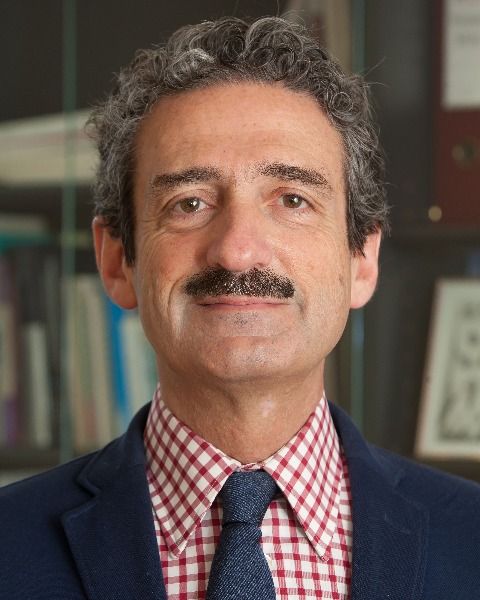Durvalumab/Bevacizumab/TACE Significantly Extends Survival in HCC
In an interview with Targeted Oncology, Bruno Sangro, MD, PhD, discussed the potential durvalumab, bevacizumab, and TACE has to set a new standard-of-care among patients with unresectable hepatocellular carcinoma.
Bruno Sangro, MD, PhD

Durvalumab (Imfinzi) in combination with transarterial chemoembolization (TACE) and bevacizumab (Avastin) demonstrated statistically significant and clinically meaningful improvements in progression-free survival (PFS) among patients with hepatocellular carcinoma (HCC) who are eligible for embolization, according to findings from the phase 3 EMERALD-1 trial (NCT03778957).1
At final PFS analysis of the study, PFS was significantly improved with the durvalumab, bevacizumab, and TACE combination at 15.0 months vs 8.2 months for those treated with TACE and placebo (hazard ratio [HR], 0.77; 95% CI, 0.61-0.98; P =.032). Results were consistent across most prespecified subgroups and with these results, the EMERALD-1 trial met its primary end point.
The secondary endpoint of PFS for durvalumab and TACE vs TACE alone was not statistically significant at a median PFS of 10.0 months vs 8.2 months (HR, 0.94; 95% CI, 0.75-1.19; P =.638). The overall response rate (ORR) was 43.6% among patients given durvalumab, bevacizumab, and TACE, 41.0% for those given durvalumab and TACE, and 29.6% for those given TACE alone. Across these arms, time to progression was 22.0, 11.5, and 10.0 months, respectively.
In addition, the safety profiles of durvalumab with TACE and bevacizumab were consistent with the known profile of each drug individually, and there were no new safety findings identified. Looking at safety analysis sets, in the durvalumab, bevacizumab, and TACE arm of 154 patients, 32.5% had a maximum grade 3/4 treatment-related adverse event (TRAE) compared with 15.1% of patients in the durvalumab and TACE arm (n = 232) and 13.5% of those on the TACE alone arm (n = 200). Across arms, 8.4%, 4.3%, and 3.5% of patients discontinued due to TRAEs, and 0%, 1.3%, and 2.0% died due to TRAEs. Patients continue to be followed for overall survival.
“I do believe that this trial has shown that durvalumab plus bevacizumab in combination with TACE has the potential to set a new standard in unresectable HCC eligible for embolization. This is something that we were eagerly awaiting after more than 20 years of managing patients with TACE alone,” Bruno Sangro, MD, PhD, told Targeted OncologyTM, in an interview.
In the interview, Sangro, director of the Liver Unit at Clínica Universidad de Navarra and a professor of medicine at the Clínica Universidad de Navarra School of Medicine in Pamplona, Spain, discussed the potential durvalumab, bevacizumab, and TACE has to set a new standard-of-care among patients with unresectable HCC.
Human liver cancer cell growth. 3d illustration: © Rasi - stock.adobe.com

Targeted Oncology: Can you provide some background on the EMERALD-1 trial?
Sangro:: Patients with unresectable hepatocellular carcinoma fit for embolization have a limited burden of disease inside the liver with no extrahepatic metastases. These patients have an unmet need because they have been treated with such embolizing procedures for the last 20 years or more with no systemic therapy having proved any benefit for this population in combination with embolization procedures. The most commonly used is transarterial chemoembolization or TACE. This is provided as 1 or more sessions of intra-arterial embolization as selectively as possible to target all tumors in the liver. Because this therapy may elicit an immunogenic response and certainly induces hypoxia with a corresponding increase in pro-angiogenic signals, it was hypothesized that combining such an embolization procedure, TACE, with systemic immunotherapy could strengthen the immune response and adding the anti-angiogenic effect on neovascularization could also be interesting.
Therefore EMERALD-1 tested TACE in combination with the durvalumab, an anti PD-L1 antibody, and bevacizumab, an anti-VEGF antibody, vs TACE alone. There was also a third of arm of TACE in combination with durvalumab. This was a phase 3 global, double-blind study that was conducted in many countries around the globe.
What did the patient population look like on this trial?
The population included patients with different burdens of disease. It is very much the population that one will have in clinical practice that is fit for TACE. This means preserved liver function, performance status of 0 or 1, free from extrahepatic disease, and where TACE can be finalized in 1, 2, 3, or even 4 sessions within a period of 16 weeks. Those were the prerequisites and that was the population that was ultimately targeted.
Patients were inclusive of all sorts of etiology of HCC, viral and nonviral. Patients were mostly free from a vascular invasion, but some patients did have limited vascular invasion, and it was also inclusive of different magnitudes of tumor burden in terms of a number of sites of liver tumors, much like we do have in clinical practice in every sense.
What end points were evaluated in this study?
The primary end point was an improvement in progression-free survival of TACE plus durvalumab plus bevacizumab vs TACE plus placebo. There were other secondary end points, all of them meaningful, including PFS of TACE plus durvalumab plus bevacizumab vs placebo, time to progression, response rate, duration of response, and safety.
What recent data were presented from the study?
What we presented were the results of the analysis. There were 4 different analyses that were preplanned. One interim and 1 final analysis on PFS. At the time of the final analysis of progression-free survival, the interim analysis of overall survival co-occurred. At that time point, the overall survival was not statistically significant in the durvalumab plus bevacizumab compared with placebo, all in combination with TACE. The trial is ongoing and participants and investigators are blinded.
What we presented is the final analysis of progression-free survival. What we were able to show is that patients treated with the combination of durvalumab, bevacizumab, and TACE had median progression-free survival of 15 months compared with only 8.2 months in the arm treated with TACE alone. Such difference in progression-free survival was not only statistically significant, but also clinically meaningful, with a hazard ratio of 0.77.
Can you discuss the safety findings?
There were no safety issues if we understand that the type and intensity of adverse events were those that could be expected for such a combination of immune-mediated adverse events related to the durvalumab and some of the adverse events related to bevacizumab that are linked to its anti-angiogenic effect. All in all, a minority of the patients experienced serious or high-intensity adverse events, possibly related to the treatment under investigation. Overall, the perception was that the treatment was safe [and] toxicities were manageable and within the expected range for the combination that was tested.
EMERALD-1 shows promise for a new treatment regimen in HCC. How might this new protocol be implemented in the community oncology setting?
I do believe that this trial has shown that durvalumab plus bevacizumab in combination with TACE has the potential to set a new standard in unresectable HCC eligible for embolization. This is something that we were eagerly awaiting after more than 20 years of managing patients with TACE alone. I believe that the added value of the systemic therapy with these 2 agents provides a clinically meaningful benefit for these patients and therefore, it could set a new standard of care in embolization eligible HCC.
What are some of the potential challenges for implementing this regimen?
The treatment of durvalumab with bevacizumab is manageable; however, it is not free from adverse events that may occur in a minority of the patients. The main challenge is being aware of the potential of treatment-related adverse events. [We must] anticipate, early diagnose, and adequately treat these adverse events because only by recognizing these potential toxicities and managing adequately, we will be able to expose patients in a reasonable way so that they can get the most benefit from the systemic therapy. What we have learned is that patients treated with TACE may receive, if they are treated appropriately, such a combination in a way that may improve their outcomes, providing a reasonable safety perspective.
Are there any patient or tumor characteristics that would guide your treatment to refer a patient to this type of treatment vs initiating TACE alone?
We did have a preplanned analysis of a large number of different subgroups of patients, including etiology, tumor burden, liver functional reserve, and many others. What we saw is that the treatment benefit of progression-free survival was very consistent across the groups, meaning that it is unlikely that 1 specific subgroup may not benefit from such therapy.
What are the overall takeaways from the study?
Overall, what this analysis has shown is that for meaningful endpoints in this situation, such as progression-free survival, the combination that was tested is clinically relevant for patient benefit. The magnitude of the improvement in progression-free survival is such that I think this is a treatment that has to be considered, if approved, in any conversation for a patient with unresectable HCC fit for embolization.
Were there any specific trials or results presented at the recent ASCO Gastrointestinal (GI) Cancers Symposium that caught your attention?
What was interesting is to see that HCC is not any more a tumor that is marginally represented in a large meeting like ASCO GI because there is a lot of investigation going on, not only related to the development of new compounds, targeting different pathways that may be combined with the standard-of-care in the advanced setting, which is immunotherapy using immune checkpoint inhibitors, but also in the identification of patients who benefit more or less. Both are equally important from the available therapies. Also, the development of new biomarkers for patient selection. There is a lot of interest. Interest drives research, and research drives patient benefit.
I think the most relevant piece of information that was presented was indeed EMERALD-1. We will have to wait for regulatory agencies to consider whether the treatment should be approved. If so, I think community oncologists now have a tool to better treat the patients that are considered for embolization, particularly for TACE.









